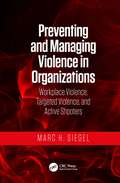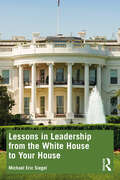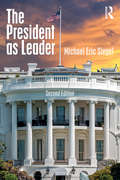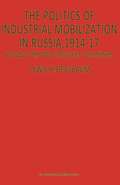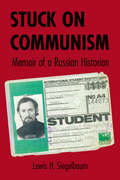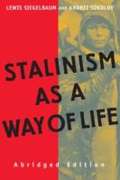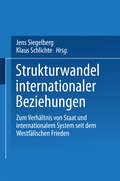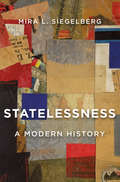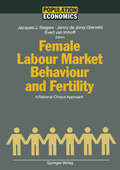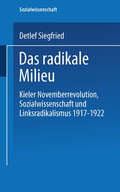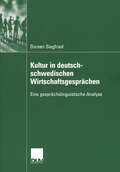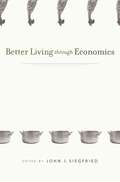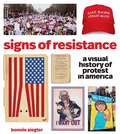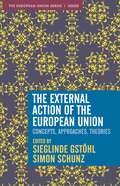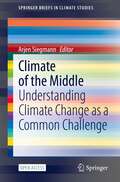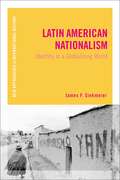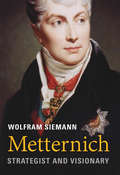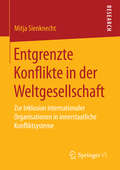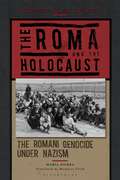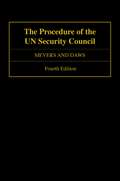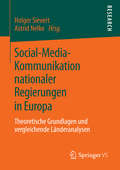- Table View
- List View
Preventing and Managing Violence in Organizations: Workplace Violence, Targeted Violence, and Active Shooters
by Marc H. SiegelOrganizations of all types and sizes, whether they are a business, educational institution, healthcare provider, or house-of-worship, need to plan for the possibility of violent acts that may impact its people, assets, and activities. Preventing and Managing Violence in Organizations: Workplace Violence, Targeted Violence, and Active Shooters provides a comprehensive approach to addressing workplace violence, active shooter and assailant events, and other forms of targeted violence. The book takes a unique perspective that the prevention and management of violence in an organization is a risk and business management issue, rather than a siloed security issue. As such, the book’s objective is to help organizations develop a program for preventing and managing violence that can be integrated into their day-to-day overall business management approach. The main theme of the book is that any program to prevent and manage violence in an organization needs to be an inclusive process: where everyone in the organization is viewed as a risk maker and risk taker, and therefore, a risk manager. The emphasis is on building a risk and security awareness culture in the organization so that everyone throughout the organization is aware and part of the solution. The book recognizes that many, if not most, organizations do not have a dedicated chief security officer to oversee the prevention and management of violence. It also recognizes that many resource allocation decisions are made by business managers, not the security manager. While other books approach this issue from a security perspective, this book takes the perspective that providing a safe and secure environment within the organization, and protecting its people, assets, and activities, is a business management imperative. Therefore, the book emphasizes the need to promote a risk and security awareness culture that is integrated into the organization's system of management and all its activities and functions. The "Introduction" section of the book includes a brief description of violence in organizations and the imperative for integrating the prevention and management of violence into the organization’s overall business management strategy. The "Framework" section helps business, human resource, risk, security, and safety managers build a programmatic framework to support prevention and management of violence in all the organizations activities. The "Tactics and Control Measures" section provides tactical and operational advice and tools on methods to prevent, respond to, and recover from potentially violent events. For organizations that have adopted an ISO, Robust Process Improvement, or Six-Sigma management systems approach, they will immediately recognize that the elements described in the framework can be integrated seamlessly into their overall management system approach. Preventing and Managing Violence in Organizations illustrates a systems approach for preventing and managing violence in organizations that can also be used for managing other types of operational risks. Security managers will find the book useful for integrating security in the organization’s day-to-day activities—as an integral part of these activities—rather than an add-on activity. Security professionals will be able to present their program from a business and risk management perspective.
Lessons in Leadership from the White House to Your House
by Michael Eric SiegelThis book argues that we can learn a great deal about leadership from the experiences of eight US presidents who have served in the White House since Watergate. The eight presidents considered here differed widely in their family backgrounds, wealth, education, age, prior political experiences, and motivations for power. But they all made the same promise—to “faithfully execute the Office of President of the US and … preserve, protect, and defend the Constitution of the United States”—and they all faced considerable challenges in fulfilling that promise. While all eight presidents had policy successes and failures, the author argues that we gain real insight on their leadership acumen by analyzing the deeper structures of leadership effectiveness that all leaders need to address: vision, execution, management, and decision-making. The book assesses the performance of each president along these four dimensions of leadership and extends lessons learned to leaders in other sectors.
Lessons in Leadership from the White House to Your House
by Michael Eric SiegelThis book argues that we can learn a great deal about leadership from the experiences of eight US presidents who have served in the White House since Watergate. The eight presidents considered here differed widely in their family backgrounds, wealth, education, age, prior political experiences, and motivations for power. But they all made the same promise—to “faithfully execute the Office of President of the US and … preserve, protect, and defend the Constitution of the United States”—and they all faced considerable challenges in fulfilling that promise. While all eight presidents had policy successes and failures, the author argues that we gain real insight on their leadership acumen by analyzing the deeper structures of leadership effectiveness that all leaders need to address: vision, execution, management, and decision-making. The book assesses the performance of each president along these four dimensions of leadership and extends lessons learned to leaders in other sectors.
The President as Leader
by Michael Eric SiegelBy analyzing the leadership skills of seven recent American presidents, this book seeks to de-mystify the elements and dynamics of effective presidential leadership which our democracy has come to depend upon and value. Building on the pioneering work of political scientist Fred Greenstein and others, this book argues that leadership in the White House can be explained and assessed by using a consistent set of criteria to analyze presidential performance. Siegel shows that presidential leadership is exercised by real, flawed human beings, and not by superheroes or philosopher-kings beyond the reach of scrutiny or critique. New to the Second Edition Includes a new chapter covering both terms of the Obama administration. Applies the author’s four-part leadership framework to the early part,of the Trump administration. Discusses the possibilities of presidential leadership in an era of intense partisanship.
The President as Leader
by Michael Eric SiegelBy analyzing the leadership skills of seven recent American presidents, this book seeks to de-mystify the elements and dynamics of effective presidential leadership which our democracy has come to depend upon and value. Building on the pioneering work of political scientist Fred Greenstein and others, this book argues that leadership in the White House can be explained and assessed by using a consistent set of criteria to analyze presidential performance. Siegel shows that presidential leadership is exercised by real, flawed human beings, and not by superheroes or philosopher-kings beyond the reach of scrutiny or critique. New to the Second Edition Includes a new chapter covering both terms of the Obama administration. Applies the author’s four-part leadership framework to the early part,of the Trump administration. Discusses the possibilities of presidential leadership in an era of intense partisanship.
The Politics of Industrial Mobilization in Russia, 1914–17: A Study of the War-Industries Committees (St Antony's Ser.)
by Lewis H SiegelbaumStuck on Communism: Memoir of a Russian Historian (NIU Series in Slavic, East European, and Eurasian Studies)
by Lewis H. SiegelbaumThis memoir by one of the foremost scholars of the Soviet period spans three continents and more than half a century—from the 1950s when Lewis Siegelbaum's father was a victim of McCarthyism up through the implosion of the Soviet Union and beyond. Siegelbaum recreates journeys of discovery and self-discovery in the tumult of student rebellion at Columbia University during the Vietnam War, graduate study at Oxford, and Moscow at the height of détente. His story takes the reader into the Soviet archives, the coalfields of eastern Ukraine, and the newly independent Uzbekistan.An intellectual autobiography that is also a biography of the field of Anglophone Soviet history, Stuck on Communism is a guide for how to lead a life on the Left that integrates political and professional commitments. Siegelbaum reveals the attractiveness of Communism as an object of study and its continued relevance decades after its disappearance from the landscape of its origin.Through the journey of a book that is in the end a romance, Siegelbaum discovers the truth in the notion that no matter what historians take as their subject, they are always writing about themselves.
Stalinism as a Way of Life: A Narrative in Documents (PDF)
by Lewis Siegelbaum Andrei SokolovIn this unique book, an abridged edition of an earlier highly praised work, we hear the poignant voices of those who experienced firsthand the complex and perilous world of the Soviet Union under Stalin.
Strukturwandel internationaler Beziehungen: Zum Verhältnis von Staat und internationalem System seit dem Westfälischen Frieden
by Jens Siegelberg Klaus SchlichteAus historischer Perspektive sollen die Grundlagen, die Entwicklung und die Erosion der "Westfälischen Ordnung" thematisiert werden, die bis in die jüngste Vergangenheit als Grundlage des modernen Staatensystems und der internationalen Politik und Beziehungen galt, gegenwärtig jedoch wachsenden Erosionsprozessen unterworfen ist. Die einzelnen Beiträge werden Stationen dieses Wandlungsprozesses beleuchten, Spezifika der jeweiligen Epoche hervorheben oder im historischen Längsschnitt den Formwandel konstitutiver Momente und zentraler Aspekte des Themas untersuchen.
Statelessness: A Modern History
by Mira L. SiegelbergThe story of how a much-contested legal category—statelessness—transformed the international legal order and redefined the relationship between states and their citizens.Two world wars left millions stranded in Europe. The collapse of empires and the rise of independent states in the twentieth century produced an unprecedented number of people without national belonging and with nowhere to go. Mira Siegelberg’s innovative history weaves together ideas about law and politics, rights and citizenship, with the intimate plight of stateless persons, to explore how and why the problem of statelessness compelled a new understanding of the international order in the twentieth century and beyond.In the years following the First World War, the legal category of statelessness generated novel visions of cosmopolitan political and legal organization and challenged efforts to limit the boundaries of national membership and international authority. Yet, as Siegelberg shows, the emergence of mass statelessness ultimately gave rise to the rights regime created after World War II, which empowered the territorial state as the fundamental source of protection and rights, against alternative political configurations.Today we live with the results: more than twelve million people are stateless and millions more belong to categories of recent invention, including refugees and asylum seekers. By uncovering the ideological origins of the international agreements that define categories of citizenship and non-citizenship, Statelessness better equips us to confront current dilemmas of political organization and authority at the global level.
Female Labour Market Behaviour and Fertility: A Rational-Choice Approach (Population Economics)
by Jacques J. Siegers Jenny De Jong-Gierveld Evert Van ImhoffSince 1987, the investigation of the relationship between female labour market behaviour and fertility, which forms part of the research programme of the Economic Institute / Centre for Interdisciplinary Research on Labour Market and Distribution Issues (CIAV) of Utrecht University, also became a part of the research programme of the Netherlands Interdisciplinary Demographic Institute (NIDI). Since then, I have been entrusted with research on this topic. In this context, I acted on a suggestion made by Frans Willekens to organize an international workshop, with the help of other members of the NIDI staff and with the administrative and organizational support of the NIDI. This resulted in the workshop "Female Labour Market Behaviour and Fertility: Preferences, Restrictions, Behaviour," held at the Netherlands Interdisciplinary Demographic Institute in The Hague, April 20-22, 1989, under the auspices of the European Association for Population Studies (EAPS). In this workshop, demographers, econometricians, economists, psychologists and socio logists discussed the paths to a truly interdisciplinary approach to the relationship between female labour market behaviour and fertility. Such an interdisciplinary approach requires a common theoretical framework. The rational-choice framework was considered to be best suited to this purpose. As a consequence, the workshop was not only structured by what was studied, but also by how it was studied. This volume consists of the papers presented at the above-mentioned workshop, as revised by the authors in collaboration with the editors.
Das radikale Milieu: Kieler Novemberrevolution, Sozialwissenschaft und Linksradikalismus 1917 – 1922 (Sozialwissenschaft)
by Detlef SiegfriedAls soziale Bewegung der Revolutionszeit zwischen 1917 und 1922 zog der Linksradikalismus eine Reihe jüngerer Sozialwissenschaftler an. Detlef Siegfried untersucht die Bindekräfte und Beziehungsnetze eines Intellektuellenmilieus, das am Kieler Institut für Weltwirtschaft entstand sowie eine rätekommunistischen Strömung, die besonders stark von Intellektuellen geprägt war.
Kultur in deutsch-schwedischen Wirtschaftsgesprächen: Eine gesprächslinguistische Analyse
by Doreen SiegfriedDoreen Siegfried weist durch die empirische Analyse deutsch-schwedischer Wirtschaftsgespräche nach, dass Kultur kein omnirelevanter Faktor ist, der die Verständigung in zweitsprachlichen Interaktionen erschwert und negative interaktionale Konsequenzen für die Gesprächsorganisation hat.
Better Living through Economics
by John J. SiegfriedFrom the late fifteenth to the eighteenth centuries, the imagination came to be recognized in South Indian culture as the defining feature of human beings. Shulman elucidates the distinctiveness of South Indian theories of the imagination and shows how they differ radically from Western notions of reality and models of the mind.
Signs of Resistance: A Visual History of Protest in America
by Bonnie Siegler&“Clever images of dissent are not a recent phenomenon in the United States. . . . [Signs of Resistance is] visually fascinating. . . . [and] there is bigly wit here, too.&”—The Washington Post In hundreds of iconic, smart, angry, clever, unforgettable images, Signs of Resistance chronicles what truly makes America great: citizens unafraid of speaking truth to power. Two hundred and forty images—from British rule and women&’s suffrage to the civil rights movement and the Vietnam War; from women&’s equality and Black Lives Matter to the actions of our forty-fifth president and the Women&’s March—offer an inspiring, optimistic, and visually galvanizing history lesson about the power people have when they take to the streets and stand up for what&’s right.
The External Action of the European Union: Concepts, Approaches, Theories (The European Union Series)
by Sieglinde Gstöhl and Simon SchunzThis groundbreaking new textbook offers extensive coverage of EU External Action studies, from its major concepts to the key theories in the field. Over the past decades, the European Union has progressively developed into a significant global actor in an increasing number of policy fields. This long-awaited volume looks into different ways of conceptualizing the EU as a global actor, the processes and impact of EU external action, explanations offered by IR and integration theories, the discursive, normative, practice and gender ‘turns’, and the ‘decentring agenda’ for EU external action. The book offers a reader-friendly guidance on these various ways in which to study the EU as a global actor: each chapter introduces one concept, approach or theory and illustrates its application by a case study of EU external action. In drawing the different perspectives together, the book underscores that ‘EU External Action Studies’ is becoming an academic speciality in its own right. Written by leading experts, the volume will make essential reading for students, scholars and practitioners of EU external action.EU External Action Studies nowadays attract attention from scholars and students in International Relations (IR), Foreign Policy Analysis and (interdisciplinary) EU Studies, as well as from practitioners.
Climate of the Middle: Understanding Climate Change as a Common Challenge (SpringerBriefs in Climate Studies)
by Arjen SiegmannThis Open Access book presents a multidisciplinary perspective to increase our understanding of climate policies that are rooted in the natural moral inclinations of people, families and firms. Which policies prevent a widening gap between higher and lower educated people? Which policy instruments are there, and how could they be used? What is the role of free entrepreneurship?In this book, academics from different fields have brought together their knowledge and expertise to reflect on the following three questions: How are the polarised positions on climate change of different groups related to their moral outlook, world view, tradition, cultural norms and values? What is a good distribution of responsibilities between firms, households and the government relating to climate change? What are possible avenues where the climate policies are a natural extension of moral inclinations of families and firms, such as the stewardship for the natural environment and the climate? This book will be of interest to policy and decision-makers, students of social and behavioural sciences, and those interested climate change policies and how this effects our lives
Latin American Nationalism: Identity in a Globalizing World (New Approaches to International History)
by James F. SiekmeierWith ethnic and class-based national movements taking center stage in countries like Bolivia and Venezuela, nationalism has proven to be one of the most durable and important movements in Latin America. In understanding the history of these nationalisms, we can understand how Latin America relates to the rest of the world. As Latin America inserts itself into a rapidly globalizing world, understanding the changing nature of national identify and nationalism is key. By tracing the important historical origins of present-day Latin American nationalism, this book gives readers a thorough introduction to the subject. Only by understanding how nationalism came to be such an important social and political force, can we understand its significance today. In turn, understanding Latin American nationalism helps us understand how Latin America shapes, and is shaped by, a rapidly globalizing world.
Latin American Nationalism: Identity in a Globalizing World (New Approaches to International History #Vol. 6)
by James F. SiekmeierWith ethnic and class-based national movements taking center stage in countries like Bolivia and Venezuela, nationalism has proven to be one of the most durable and important movements in Latin America. In understanding the history of these nationalisms, we can understand how Latin America relates to the rest of the world. As Latin America inserts itself into a rapidly globalizing world, understanding the changing nature of national identify and nationalism is key. By tracing the important historical origins of present-day Latin American nationalism, this book gives readers a thorough introduction to the subject. Only by understanding how nationalism came to be such an important social and political force, can we understand its significance today. In turn, understanding Latin American nationalism helps us understand how Latin America shapes, and is shaped by, a rapidly globalizing world.
Metternich: Strategist and Visionary (Beck'sche Reihe - Band 2484 Ser.)
by Wolfram SiemannWolfram Siemann tells a new story of Clemens von Metternich, the Austrian at the center of nineteenth-century European diplomacy. Known as a conservative and an uncompromising practitioner of realpolitik, in fact Metternich accommodated new ideas of liberalism and nationalism insofar as they served the goal of peace. And he promoted reform at home.
Entgrenzte Konflikte in der Weltgesellschaft: Zur Inklusion internationaler Organisationen in innerstaatliche Konfliktsysteme
by Mitja SienknechtIn diesem Buch wird die Annahme, dass zeitgenössische innerstaatliche Konflikte von vielfältigen Entgrenzungsprozessen geprägt sind, sowohl theoretisch hergeleitet als auch empirisch plausibilisiert. Ein besonderer Fokus liegt dabei auf der Inklusion internationaler Organisationen. Es wird ein theoretisches Modell entwickelt, welches Annahmen der Weltgesellschaftstheorie und der Friedens- und Konfliktforschung miteinander verbindet. Dieses wird am Beispiel des Konfliktes zwischen der türkischen Regierung und der PKK sowie deren Inklusionsbemühungen gegenüber der EU überprüft. Die Analyse zeigt, dass die Konfliktparteien aktiv zur Entgrenzung des Konfliktes entlang einer territorialen, symbolischen und funktionalen Dimension beitragen. Auf diese Weise werden Strukturen ins weltpolitische System aufgebaut und die Form des Konfliktes verändert sich.
The Roma and the Holocaust: The Romani Genocide under Nazism (Perspectives on the Holocaust)
by Professor María SierraHalf a million European Roma were exterminated by the Nazi regime; many more were subjected to a policy of racial discrimination similar to that suffered by the Jewish people. However, the persecution and torment of Roma in Hitler's Europe has little presence in the history books. The Roma and the Holocaust places the Roma genocide in the context of the widespread violence of the Second World War, while offering an explanation that places it within a broader trajectory of anti-Roma persecution in modern societies.The book explores the separation and destruction of families, the sterilisation of adults and children, the plunder of property and deprivation of livelihoods, slave labour, medical experiments, the horror of extermination camps and the mass murder that the Romani people were subjected to. María Sierra uses the first section of the book to provide a much-needed critical overview and synthesis of the fragmented research and scholarship in the area that has been conducted in various languages. In the second section, Sierra shines a light the autobiographical accounts of several Roma survivors of the Nazi genocide in order for the voices of the victims who have claimed recognition and rights for the Roma people to be heard. This journey through the memories of Philomena Franz, Ceija Stojka, Lily Van Angeren, Otto Rosenberg, Walter Winter and Ewald Hanstein, in addition to other testimonies, is contextualized within the framework of other Holocaust survivors' memoirs and has been approached from a history of emotions perspective.With the Romani people having been denied recognition as victims of Nazism after the end of the war, this book crucially helps to bring about agency for the survivors, supporting their struggle for the right to memory in the process.
The Roma and the Holocaust: The Romani Genocide under Nazism (Perspectives on the Holocaust)
by Professor María SierraHalf a million European Roma were exterminated by the Nazi regime; many more were subjected to a policy of racial discrimination similar to that suffered by the Jewish people. However, the persecution and torment of Roma in Hitler's Europe has little presence in the history books. The Roma and the Holocaust places the Roma genocide in the context of the widespread violence of the Second World War, while offering an explanation that places it within a broader trajectory of anti-Roma persecution in modern societies.The book explores the separation and destruction of families, the sterilisation of adults and children, the plunder of property and deprivation of livelihoods, slave labour, medical experiments, the horror of extermination camps and the mass murder that the Romani people were subjected to. María Sierra uses the first section of the book to provide a much-needed critical overview and synthesis of the fragmented research and scholarship in the area that has been conducted in various languages. In the second section, Sierra shines a light the autobiographical accounts of several Roma survivors of the Nazi genocide in order for the voices of the victims who have claimed recognition and rights for the Roma people to be heard. This journey through the memories of Philomena Franz, Ceija Stojka, Lily Van Angeren, Otto Rosenberg, Walter Winter and Ewald Hanstein, in addition to other testimonies, is contextualized within the framework of other Holocaust survivors' memoirs and has been approached from a history of emotions perspective.With the Romani people having been denied recognition as victims of Nazism after the end of the war, this book crucially helps to bring about agency for the survivors, supporting their struggle for the right to memory in the process.
The Procedure Of The Un Security Council
by Loraine Sievers Sam DawsThe Procedure of the UN Security Council is the definitive book of its kind and has been widely used by UN practitioners and scholars for nearly 40 years. This comprehensively revised edition contains over 450 pages of new material documenting the extensive and rapid innovations in the Council's procedures of the past two decades. A one-stop handbook and guide, with meticulous referencing, this book has served diplomats, UN staff and scholars alike in providing unique insight into the inside workings of the world's preeminent body for the maintenance of international peace and security. Thoroughly grounded in the history and politics of the Council, it brings to life the ways the Council has responded through its working methods to a changing world. The book explains the Council's role in its wider UN Charter context and examines its relations with other UN organs and with its own subsidiary bodies. This includes the remarkable expansion in UN peacekeeping, peacebuilding and political missions, sanctions and counter-terrorism bodies, and international legal tribunals. It contains detailed analysis of voting and decision-taking by the Council, as well as the place, format, and conduct of meetings. It also seeks to illuminate the personalities behind the Council's work - ranging from the diplomats who sit on the Council itself to the UN Secretary-General, and those outside the Council affected by its decisions. It concludes with reflections on the improvements that have made to the Council's procedures over many decades, and the scope for further reform.
Social-Media-Kommunikation nationaler Regierungen in Europa: Theoretische Grundlagen und vergleichende Länderanalysen
by Holger Sievert Astrid NelkeKommunikation über Social Media gewinnt immer mehr an Bedeutung. Echtzeit-Ansprüche,Transparenz-Wünsche und Dialog-Möglichkeiten im Web 2.0 stellen nicht zuletzt die politische Kommunikation vor neue Herausforderungen. Inwieweit nationale Regierungen diese "neuen" Kommunikationstools nutzen und welchen Stellenwert sie dabei dem Austausch mit dem Bürger einräumen, haben Forschende und Studierende der Macromedia Hochschule für Medien und Kommunikation (MHMK) für ausgewählte Staaten in Europa untersucht. Die Herausgeber stellen die wichtigsten Befunde der Inhaltsanalyse vor, die vom Presse- und Informationsamt der Bundesregierung unterstützt wurde. Aktuelle weitere Fachbeiträge ergänzen den Sammelband.
